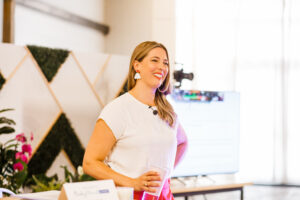NAVIGATING change for me is really about navigating resistance.
Have you ever noticed that oak trees don’t drop their leaves until spring? They hold onto their leaves all winter and eventually let them go as, or just before, the new leaves emerge.
I notice it, and I wonder: Is there a reason they hold on so long?
What are the benefits the oak trees give themselves by keeping their leaves all winter?
Why do they resist the release?
When I’m navigating change, especially when the request to change is coming from outside of myself, I see myself in the oak trees.

I’m a wait-er. I am resistant.
I’ve noticed that when dealing with external changes, changes that are being proposed to me, my first reaction is resistance.
Resistance to the newness. Resistance to how the impending change will impact my personal life. Resistance to my “normal.”
I get angry, annoyed, irritable. I question why I’m having to do whatever it is I’m having to do. I am stubborn and defiant.
I can view my resistance as being whiny, self-victimizing and immature.
I’m not recommending resistance as the BEST response one might have to change.
It’s usually not the best response for me to have, yet it is what shows up first when navigating change.
With even simple things, resistance is first to show up. Whenever my aerial silks instructor shows me a new skill, I usually end up laughing at her and say, “Ha! You want me to do what??” I can’t fathom that what she demonstrates is possible for me. I’m not the one that jumps up and tries it out. I wait and see.
For me to move through my resistance to outer demands, I have to find a piece of the impending change to hook into. I find implementing the change is easier when I have a personal “buy in” to what is being mandated, proposed, or expected.
Once I have that, then I’m able to “go along” with it.

I can let my metaphorical “leaves” fall and let the new ones grow.
So as I sit in my aerial class that I invested in, I’ll watch a few other students try the new skill first. I’m sitting there, encouraging them to go for it, but in my head I’m looking at the other older students to see if “we” can do it. I let my visual learner skills kick in so that through watching, I can learn. Then there’s a moment when I see that it is safe, that there’s really nothing to worry about, and I get off the mat and give it a try. I navigate my resistance by observing and seeing their success, thinking maybe I can succeed too.
I experience waiting and resistance differently when the inspiration for change is coming from inside me, from me following my inner guidance. Instead of having to do mental and emotional gymnastics to accept a new idea, I see the resistance of others when I share or act on my idea.
Last month I thought for a while about moving the living room furniture around. When I finally acted on it, my desire for change was met with resistance. First, I had resistance in moving the actual furniture. I had to overcome inertia to get the couch and bookshelf to move. Then later, I met resistance from my hubby when he asked me why I was moving it around. “Wasn’t it just fine where it was?”
Resistance to change has a purpose.
Change will always meet with resistance. It has to. If change did not meet with resistance, we’d be making changes for the sake of making changes and there’d be chaos without integration.
Just like the oak trees that keep their old leaves through the “false springs” of the rare 60 degree days in January, resistance allows the change to prove itself. If a new idea can withstand the stress of proving its worth, it will persevere.
My internal resistance to external change is my way of seeing if an idea is good enough for me to keep or use. The external resistance from internal change shows me what does and doesn’t work. And, it lets me make a new choice to change.
As I reflect on what navigating change looks like for me, I want to acknowledge that this article is from the perspective of a white woman with privilege. I recognize that my stubbornness is a privilege not allowed for all. And as we all navigate the resistance that comes with change, may it lead us to greater equality, access, and acceptance.
With the experience and awareness that I’ve gained through BodyMind coaching and living, the following questions now come to mind for me as a path for doing just that.
For internal resistance I ask:
—How can I soften my resistance to this change?
—What about this change is triggering my resistance?
—Where is this resistance rooted?
—If the resistance is rooted in a perception of lack, can I give myself right now the thing/emotion/acknowledgment I feel I’m lacking?
—As I do that, how can I more easily move forward now?
For external resistance:
—Will informing others of the change prior to it occurring be helpful? (for all my Human Design readers, this is part of my Manifesting Generator strategy)
—Do I have to feel attacked when others share their resistance with me?
—What does the resistance of others show me? Is there anything helpful in their feedback?
—As I acknowledge their resistance, what does my body say?
—Is the change still correct for me through the lens of my body’s wisdom?
These are questions I engage with now.
I did not have the tools, language, or self confidence to explore these questions before becoming a BodyMind coach.

I invite you to play with them the next time you’re encountering resistance to change.
I invite you to play!
MARY PAT CURRAN, LMT
BodyMind Coach
As the owner of Intentional Flow Mary Pat Curran coaches her clients using her gifts of presence and possibility. Mary Pat (MP) was an educator of adults & youth for 13 years prior to attending massage school. In 2013 she opened her own business and in 2018 began offering BodyMind Coaching as a missing piece for her clients’ transformation.
Mary Pat loves helping her clients learn more about themselves so that they can grow into their intentions without having to become someone else to succeed. Through embodying their unique values, goals, and desires. MP’s clients not only reach their goals, they become who they are meant to be.
Originally from Chicago, Mary Pat currently resides in Lexington, Kentucky with her hubby, children and dog.
IG: @IntentionalFlow
FB: Intentional Flow
LI: Mary Pat Curran




